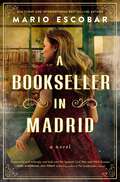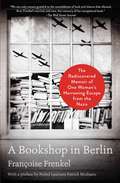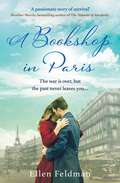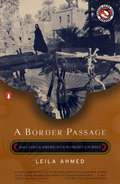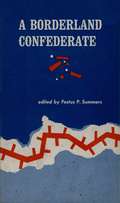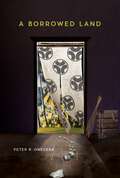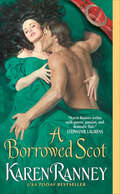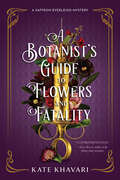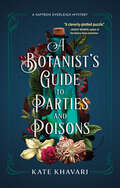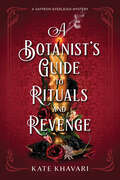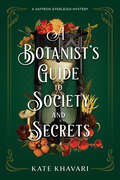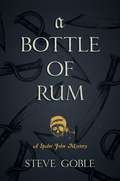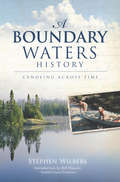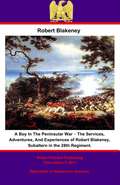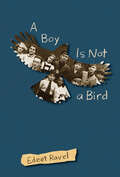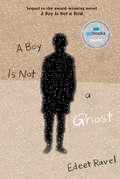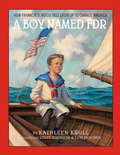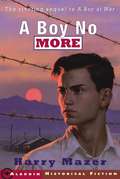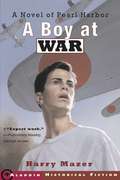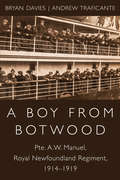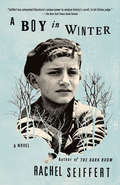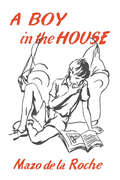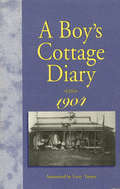- Table View
- List View
A Bookseller in Madrid: A Novel
by Mario EscobarHow can the words of the past help heal the horror of the present?For as long as she can remember, Barbara Spiel has always found solace in books. Born in Germany and having come of age in a tumultuous era, she flees her home country as the Nazis rise to power in the early 1930s. Her destination? Madrid. There she's determined to realize her long-held dream of opening a bookshop and creating a safe haven for young idealists and independent thinkers to come together to transform the world.Yet Spain isn't immune from its own troubles. The winds of change are blowing through both city and countryside, and it's impossible to predict what will happen. When the outbreak of the Spanish Civil War puts Barbara and everyone around her in peril--including the Spanish Socialist parliamentarian she's fallen deeply in love with--the terror and hatred seem all too familiar. It's like Germany all over again, only with its own cast of extremist characters.Hounded simultaneously by Stalinist checas, Francoist Facists, and the German Gestapo, Barbara fights to keep her bookstore the safe haven that she's always imagined it would be. But with war brewing both inside Spain and outside its borders throughout the entirety of Europe--and beyond--Barbara isn't sure who exactly she can trust, or if people really are who they claim to be.A story told with tremendous heart and astonishing historical accuracy, A Bookseller in Madrid is ultimately a story about dreams--dreaming with courage when nothing seems to make sense, and dreaming with hope when words printed on a page are all you can hold on to.
A Bookshop in Berlin: The Rediscovered Memoir of One Woman's Harrowing Escape from the Nazis
by Françoise FrenkelA PEOPLE BOOK OF THE WEEK WINNER OF THE JQ–WINGATE LITERARY PRIZE &“A haunting tribute to survivors and those lost forever—and a reminder, in our own troubled era, never to forget.&” —People An &“exceptional&” (The Wall Street Journal) and &“poignant&” (The New York Times) book in the tradition of rediscovered works like Suite Française and The Nazi Officer&’s Wife, the powerful memoir of a fearless Jewish bookseller on a harrowing fight for survival across Nazi-occupied Europe.In 1921, Françoise Frenkel—a Jewish woman from Poland—fulfills a dream. She opens La Maison du Livre, Berlin&’s first French bookshop, attracting artists and diplomats, celebrities and poets. The shop becomes a haven for intellectual exchange as Nazi ideology begins to poison the culturally rich city. In 1935, the scene continues to darken. First come the new bureaucratic hurdles, followed by frequent police visits and book confiscations. Françoise&’s dream finally shatters on Kristallnacht in November 1938, as hundreds of Jewish shops and businesses are destroyed. La Maison du Livre is miraculously spared, but fear of persecution eventually forces Françoise on a desperate, lonely flight to Paris. When the city is bombed, she seeks refuge across southern France, witnessing countless horrors: children torn from their parents, mothers throwing themselves under buses. Secreted away from one safe house to the next, Françoise survives at the heroic hands of strangers risking their lives to protect her. Published quietly in 1945, then rediscovered nearly sixty years later in an attic, A Bookshop in Berlin is a remarkable story of survival and resilience, of human cruelty and human spirit. In the tradition of Suite Française and The Nazi Officer&’s Wife, this book is the tale of a fearless woman whose lust for life and literature refuses to leave her, even in her darkest hours.
A Bookshop in Paris
by Ellen FeldmanThe war is over, but the past is never past … Paris, 1944. Charlotte Foret is working in a tiny bookstore in Nazi-occupied Paris struggling to stay alive and keep her baby Vivi safe as the world around them is being torn apart. Every day they live through is a miracle until Vivi becomes gravely ill. In desperation, Charlotte accepts help from an unlikely saviour – and her life is changed forever. Charlotte is no victim – she is a survivor. But the truth of what happened in Paris is something she can never share with anyone, including her daughter. But can she ever really leave Paris behind – and survive the next chapter of her life? Seamlessly interweaving Charlotte&’s past in wartime Paris and her present in the 1950s world of New York publishing, A Bookshop in Paris is a heartbreakingly moving and unforgettable story of resilience, love – and impossible choices. 'Completely compelling. I tore through it. This novel pivots on how we manage to survive surviving ... Charlotte's visceral story will stay with me.&’ Naomi Wood, author of Mrs Hemingway &‘Masterful, magnificent. A passionate story of survival. This story will stay with me for a long time&’Heather Morris, bestselling author of The Tattooist of Auschwitz Published in the US and Australia as Paris Never Leaves You
A Booze & Vinyl Christmas: Merry Music-and-Drink Pairings to Celebrate the Season
by André DarlingtonCelebrate the holidays with this merry collection of beloved Christmas albums paired with mood-setting cocktails—a companion to the bestselling listening party guide, Booze & Vinyl. Whether you're planning your finest Ugly Christmas Sweater Party or spending a quiet evening by the stocking-lined fireside at home, make the season bright with this guide to 40 favorite holiday albums from the 1940s to the present. Each entry features liner notes on the album and accompanying boozy beverage recipes that complement the music or connect the drink to the artist. Select holiday food recipes throughout complete the experience. Among the artist albums featured are: Johnny Mathis, the Beach Boys, Elvis, the Jackson 5, Mariah Carey, Bob Dylan, Justin Bieber, Gwen Stefani, Sia, Dolly Parton, Bing Crosby, Nat King Cole, Vince Guaraldi, Barbara Streisand, Willie Nelson, Boyz II Men, Celine Dion, Carrie Underwood, Frank Sinatra, Ella Fitzgerald, Dean Martin, Michael Bublé, and John Legend.
A Border Passage: From Cairo to America--A Woman's Journey
by Leila AhmedA memoir of the author's life and understanding of her identity
A Borderland Confederate
by Festus P. Summers William Lyne WilsonWilliam Lyne Wilson was only seventeen and a half years old when South Carolina, voted for succession from the United States of America and sparked the Civil War into life. A native Virginian, Wilson, without hesitation, but with some foreboding, volunteered to join his southern brothers in arms in the Confederate Army. He was drafted into the 12th Virginia Cavalry, the Army of North Virginia, and would fight with courage and gallantry in the Shenandoah Valley, Maryland and all the way to Appomattox.
A Borrowed Land
by Peter R. OnederaA Borrowed Land tells the untold stories of Guam’s Nikkei—people of Japanese descent—before, during, and after World War II. As the descendant of an issei, or firstgeneration immigrant, Peter R. Onedera chronicles the Nikkei’s experiences in Guam from their arrival to their assimilation into the island’s life and culture, their hardship and resilience during the war, and the struggles they endured after. Onedera interweaves both historical and personal accounts to document how heritage and history shape personal and collective identity. The story also unveils the complexities of Onedera’s own healing, as he explores his CHamoruJapanese heritage and reveals the discrimination he and other Nikkei experienced in postwar Guam.
A Borrowed Scot (Tulloch Sgathan #3)
by Karen RanneyA mysterious Highlander comes to the rescue of a desperate woman with psychic gifts in the New York Times–bestselling author’s historical Scottish romance.Though she possesses remarkable talents and astonishing insight, Veronica MacLeod knows nothing about the man who appears from nowhere to prevent her from committing the most foolish act of her life. Recently named Lord Fairfax of Doncaster Hall, the breathtaking, secretive stranger agrees to perform the one act of kindness that can rescue the Scottish beauty from scandal and disgrace—by taking Veronica as his bride.Journeying with Montgomery Fairfax to his magnificent estate in the Highlands, Veronica knows deep in her heart that this is a man she can truly love—a noble soul, a caring and passionate lover whose touch awakens feelings she’s never before known. Yet there are ghosts in Montgomery’s shuttered past that haunt him still. Unless Veronica can somehow unlock the enigma that is her new husband, their powerful passion could be undone by the sins and sorrows of yesterday.
A Botanist's Guide to Flowers and Fatality (A Saffron Everleigh Mystery #2)
by Kate KhavariBrilliant botanist Saffron Everleigh is back and ready for adventure in Kate Khavari&’s next mesmerizing historical mystery. &“A cleverly plotted puzzle&” (Ashley Weaver) in the vein of Opium and Absinthe, this second installment is perfect for fans of Rhys Bowen and Sujata Massey.1920s London isn&’t the ideal place for a brilliant woman with lofty ambitions. But research assistant Saffron Everleigh is determined to beat the odds in a male-dominated field at the University College of London. Saffron embarks on her first research study alongside the insufferably charming Dr. Michael Lee, traveling the countryside with him in response to reports of poisonings. But when Detective Inspector Green is given a case with a set of unusual clues, he asks for Saffron&’s assistance.The victims, all women, received bouquets filled with poisonous flowers. Digging deeper, Saffron discovers that the bouquets may be more than just unpleasant flowers— there may be a hidden message within them, revealed through the use of the old Victorian practice of floriography. A dire message, indeed, as each woman who received the flowers has turned up dead.Alongside Dr. Lee and her best friend, Elizabeth, Saffron trails a group of suspects through a dark jazz club, a lavish country estate, and a glittering theatre, delving deeper into a part of society she thought she&’d left behind forever.Will Saffron be able to catch the killer before they send their next bouquet, or will she find herself with fatal flowers of her own in Kate Khavari&’s second intoxicating installment.
A Botanist's Guide to Parties and Poisons (A Saffron Everleigh Mystery)
by Kate KhavariThe Lost Apothecary meets Dead Dead Girls in this fast-paced, STEMinist adventure.Debut author Kate Khavari deftly entwines a pulse-pounding mystery with the struggles of a woman in a male-dominated field in 1923 London.Newly minted research assistant Saffron Everleigh is determined to blaze a new trail at the University College London, but with her colleagues&’ beliefs about women&’s academic inabilities and not so subtle hints that her deceased father&’s reputation paved her way into the botany department, she feels stymied at every turn. When she attends a dinner party for the school, she expects to engage in conversations about the university's large expedition to the Amazon. What she doesn&’t expect is for Mrs. Henry, one of the professors&’ wives, to drop to the floor, poisoned by an unknown toxin. Dr. Maxwell, Saffron&’s mentor, is the main suspect and evidence quickly mounts. Joined by fellow researcher--and potential romantic interest--Alexander Ashton, Saffron uses her knowledge of botany as she explores steamy greenhouses, dark gardens, and deadly poisons to clear Maxwell's name. Will she be able to uncover the truth or will her investigation land her on the murderer&’s list, in this entertaining examination of society&’s expectations.
A Botanist's Guide to Rituals and Revenge: A Saffron Everleigh Mystery (A Saffron Everleigh Mystery)
by Kate KhavariBrilliant botanist Saffron Everleigh faces her hardest challenge yet when she returns to her childhood home in the fourth book in the charming Saffron Everleigh mystery series. &“A cleverly plotted puzzle&” (Ashley Weaver) in the vein of Opium and Absinthe, this is perfect for fans of Rhys Bowen and Sujata Massey.Saffron Everleigh returns to Ellington Manor after her grandfather suffers a heart attack. Back in her childhood home for the first time in years, Saffron faces tense family relationships made worse by the presence of the enigmatic Bill Wyatt, hired on as a doctor to the ailing Lord Easting. But the man is no doctor—in reality, he is a mysterious figure involved in the trafficking of dangerous government secrets, and his presence at Ellington can only mean trouble.When their neighbors, the Hales, invite a spiritual medium into the village who starts angling for Saffron&’s mother&’s attention, Saffron realizes that there is more afoot in her hometown than she originally thought. Not to mention inviting Alexander to Ellington has put their budding relationship under her family&’s microscope.As tensions rise at Ellington, Bill demands that Saffron hand over old research documents belonging to her late father. With her relatives under his power as their &‘doctor,&’ Saffron fears she may be forced to surrender the files along with her hopes of ever understanding her father&’s obscure legacy. Nothing and no one is as they seem at Ellington. It&’s through the perfumed haze of the séance&’s smoke that Saffron must search for the truth before it&’s too late.
A Botanist's Guide to Society and Secrets (A Saffron Everleigh Mystery #3)
by Kate KhavariBrilliant botanist Saffron Everleigh is ready for her next thrilling adventure in the newest installment of Kate Khavari&’s mesmerizing historical mystery series. &“A cleverly plotted puzzle&” (Ashley Weaver) in the vein of Opium and Absinthe, this is perfect for fans of Rhys Bowen and Sujata Massey.London, 1923. Returning from Paris, botanical researcher Saffron Everleigh finds that her former love interest Alexander Ashton&’s brother, Adrian, is being investigated for murder. A Russian scientist working for the English government has been poisoned, and expired in Adrian&’s train compartment. Alexander asks Saffron to put in a good word for Adrian with Inspector Green. Despite her unresolved feelings for Alexander, Saffron begins to unravel mysteries surrounding the dead scientist.As if a murder case weren&’t enough, her best friend Elizabeth&’s war-hero brother, Nick, arrives in town and takes an immediate interest in Saffron. Saffron learns Alexander has been keeping secrets from her, including a connection to Nick, who Saffron and Elizabeth begin to suspect is more than he seems.When another scientist is found dead, Saffron agrees to go undercover at the government laboratory. Risking her career and her safety, she learns there are many more interested parties and dangerous secrets to uncover than she&’d realized. But some secrets, Saffron will find, are better left undiscovered.
A Bottle of Rum (A Spider John Mystery #3)
by Steve GobleAugust, 1723 -- Spider John Rush believes he has escaped piracy forever. Enjoying rum and chess in a dark Lymington tavern, he dreams of finding passage to Nantucket to reunite with his beloved Em and to finally get to know the son he remembers only as a babe in arms, though the lad must be dreaming of going to sea himself by now. But when a lazy taverner is stabbed to death, one glance at the victim tells Spider the pirate life has followed him ashore and he cannot possibly ignore this bloody crime. The wise maneuver would be to run before authorities arrive, but Spider is denied that choice because he&’s already deeply, connected to the crime—he fashioned the murder weapon with his own hands. The knife was a gift to a young man, one who ran off with the notorious Anne Bonny before Spider could drag him into a respectable life. Soon, Spider John and his ancient shipmate Odin are dodging accusations and battling smugglers on a trail that leads to a madhouse where patients are dying one by one. Spider finds himself tangling with a horribly maimed former shipmate, vengeful pirates, a gun-wielding brunette, a death-obsessed young woman, a sneaky farmhand and a philosopher engaged in frightening experiments. But death seems to be winning at Pryor Pond, and the next life lost may be the one Spider desperately wants to save. Spider must brave sharp steel, musket balls, gunpowder bombs, dangerous women and gruesome surgery if he is to find his foolish young friend alive and try once again to put piracy in their past.
A Boundary Waters History: Canoeing Across Time (Sports History Ser.)
by Stephen Wilbers Bill HansenTeasing out the history of a place celebrated for timelessness--where countless paddle strokes have disappeared into clear waters--requires a sure and attentive hand. Stephen Wilbers's account reaches back to the glaciers that first carved out the Boundary Waters and to the original inhabitants, as well as to generations of wilderness explorers, both past and present. He does so without losing the personal relationship built through a lifetime of pilgrimages (anchored by almost three decades of trips with his father). This story captures the untold broader narrative of the region, as well as a thousand different details sure to be recognized by fellow pilgrims, like the grinding rhythm of a long portage or the loon call that slips into that last moment before sleep.
A Boy In The Peninsular War – The Services, Adventures, And Experiences of Robert Blakeney, Subaltern in the 28th Regiment.: The Services, Adventures And Experiences Of Robert Blakeney, Subaltern In The 28th Regiment
by Julian Sturgis Robert BlakeneyThis ebook is purpose built and is proof-read and re-type set from the original to provide an outstanding experience of reflowing text for an ebook reader. Robert Blakeney was by modern standards a callow youth at the age of fifteen, in the standards of the time in which he lived he was a gentleman and a soldier. Blakeney was commissioned as a subaltern in the 28th Regiment, he was to see tough and trying service in the Peninsular under both Sir John Moore and the Duke of Wellington. Although the author eschews any literary pretensions, claiming that he was far too busy with his active career soldiering, the autobiography is excellently written with no little wit, aided no doubt by tight editing by Julian Sturgis. His description of the hell of Badajoz is particularly well done. Many incidents of the camp and bivouac that Blakeney recounts revolve around the characters of his soldiers, who not infrequently happen to be Irish, and the great generals that he meets in carrying out his duties; such as Sir John Moore, Lord Paget, General Graham and the Iron Duke himself. As an example of which Lord Paget is memorably recalled infusing some urgency into one of Blakeney's superiors during the retreat of 1809; 'Dragoon, what news?" "News, sir? The only news I have for you is that unless you step out like soldiers, and don't wait to pick your steps like bucks in Bond Street of a Sunday with shoes and silk stockings, damn it! you'll be all taken prisoners." "Pray, who the devil are you?" came from the cart. "I am Lord Paget," said the dragoon;' Blakeney, served during the Copenhagen expedition, the Coruña campaign including the battle, the siege of Tarifa, the battle of Barossa, the siege of Badajoz, and finally the battle of Nivelle in which he is severely wounded. A highly enjoyable and recommended read. Text taken, whole and complete, from the 1899 edition, published in London, John Murray. Original -369 pages Author - Robert Blakeney - (1789-1858) Editor - Julian Sturgis - (1848-1904) Map - Not included due to its size Linked TOC.
A Boy Is Not a Bird
by Edeet RavelA young boy named Natt finds his world overturned when his family is uprooted and exiled to Siberia during the occupation of the Soviet Ukraine by Nazi Germany. In 1941, life in Natt’s small town of Zastavna is comfortable and familiar, even if the grownups are acting strange, and his parents treat him like a baby. Natt knows there’s a war on, of course, but he’s glad their family didn’t emigrate to Canada when they had a chance. His mother didn’t want to leave their home, and neither did he. He especially wouldn’t want to leave his best friend, Max. Max is the ideas guy, and he hears what’s going on in the world from his older sisters. Together the boys are two brave musketeers. Then one day Natt goes home and finds his family huddled around the radio. The Russians are taking over. The churches and synagogues will close, Hebrew school will be held in secret, and there are tanks and soldiers in the street. But it’s exciting, too. Natt wants to become a Young Pioneer, to show outstanding revolutionary spirit and make their new leader, Comrade Stalin, proud. But life under the Russians is hard. The soldiers are poor. They eat up all the food and they even take over Natt’s house. Then Natt’s father is arrested, and even Natt is detained and questioned. He feels like a nomad, sleeping at other people’s houses while his mother works to free his father. As the adults try to protect him from the reality of their situation, and local authorities begin to round up deportees bound for Siberia, Natt is filled with a sense of guilt and grief. Why wasn’t he brave enough to look up at the prison window when his mother took him to see his father for what might be the last time? Or can just getting through war be a heroic act in itself? Key Text Features historical note map author’s note Correlates to the Common Core State Standards in English Language Arts: CCSS.ELA-LITERACY.RL.6.3 Describe how a particular story's or drama's plot unfolds in a series of episodes as well as how the characters respond or change as the plot moves toward a resolution.
A Boy Is Not a Ghost
by Edeet RavelIn this sequel to the award-winning A Boy Is Not a Bird, a boy is exiled to Siberia during World War II. Based on a true story. Torn from his home in Eastern Europe, with his father imprisoned in a Siberian gulag, twelve-year-old Natt finds himself stranded with other deportees in a schoolyard in Novosibirsk. And he is about to discover that life can indeed get worse than the horrific two months he and his mother have spent being transported on a bug-infested livestock train. He needs to write to his best friend, Max, but he knows the Soviet police reads everyone’s mail. So Natt decides to write in code, and his letters are a lifeline, even though he never knows whether Max will receive them. Every day becomes a question of survival, and where they might be shunted to next. When his mother is falsely arrested for stealing potatoes, Natt is truly on his own and must learn how to live the uncertain life of an exile. Practice being invisible as a ghost, change your name and identity if you have to, watch out for spies, and never draw the attention of the authorities. Even then, he will need luck on his side if he is ever going to be reunited with his family. Key Text Features author's note Illustrations map Correlates to the Common Core State Standards in English Language Arts: CCSS.ELA-LITERACY.RL.4.3 Describe in depth a character, setting, or event in a story or drama, drawing on specific details in the text (e.g., a character's thoughts, words, or actions). CCSS.ELA-LITERACY.RL.5.3 Compare and contrast two or more characters, settings, or events in a story or drama, drawing on specific details in the text (e.g., how characters interact). CCSS.ELA-LITERACY.RL.5.4 Determine the meaning of words and phrases as they are used in a text, including figurative language such as metaphors and similes. CCSS.ELA-LITERACY.RL.5.6 Describe how a narrator's or speaker's point of view influences how events are described. CCSS.ELA-LITERACY.RL.5.7 Analyze how visual and multimedia elements contribute to the meaning, tone, or beauty of a text (e.g., graphic novel, multimedia presentation of fiction, folktale, myth, poem).
A Boy Named FDR: How Franklin D. Roosevelt Grew Up to Change America
by Kathleen Krull Steve Johnson Lou FancherFranklin D. Roosevelt was born into one of the wealthiest families in America, yet this ultimate rich kid grew up to do more for ordinary Americans than any other president. <P><P>This appealing picture book biography shows how, from childhood on, FDR was compassionate, cheerful, determined, and enormously likable. Though he had private tutors as a young boy and later attended an elite boys' school, he played pranks and had down-to-earth fun just like any boy today. <P><P>Kathleen Krull's animated picture book biography focuses on FDR's childhood years through his entry as a young man into politics and his battle with polio. A summary of his achievements as president and a chronology of his life are included. The well-researched text and the evocative illustrations by Steve Johnson and Lou Fancher provide an inspiring introduction to one of our greatest presidents.
A Boy No More
by Harry Mazer"WHAT ABOUT WHAT THEY DID TO MY FATHER?... <P> THE JAPS KILLED HIM!" <P> Adam Pelko witnessed something horrible: the sinking of the USS Arizona during the attack on Pearl Harbor -- with his father aboard. Since then, Adam and his mother and sister have moved to California, where they are trying to rebuild their lives. <P> But no matter where Adam goes, he can't get away from the effects of the war. His best friend, Davi, has asked for help. Davi is Japanese American, and his father has been arrested, taken to Manzanar, a Japanese internment camp. <P> Adam isn't sure what to do. If he goes to Manzanar and starts asking questions, he could be risking his own life. But can he simply do nothing and risk losing Davi's friendship forever? Are Davi, his father, and all the other Japanese Americans taken from their homes responsible for what happened at Pearl Harbor? <P> In this riveting follow-up to his acclaimed book A Boy at War, Harry Mazer explores questions of friendship and loyalty against the backdrop of World War II, a time when boys had to grow up fast.
A Boy at War: A Novel of Pearl Harbor
by Harry MazerThey rowed hard, away from the battleships and the bombs. Water sprayed over them. The rowboat pitched one way and then the other. Then, before his eyes, the Arizona lifted up out of the water. That enormous battleship bounced up in the air like a rubber ball and split apart. Fire burst out of the ship. A geyser of water shot into the air and came crashing down. Adam was almost thrown out of the rowboat. He clung to the seat as it swung around. He saw blue skies and the glittering city. The boat swung back again, and he saw black clouds, and the Arizona, his father's ship, sinking beneath the water. -- from A Boy at War "He kept looking up, afraid the planes would come back. The sky was obscured by black smoke....It was all unreal: the battleships half sunk, the bullet holes in the boat, Davi and Martin in the water." December 7, 1941: On a quiet Sunday morning, while Adam and his friends are fishing near Honolulu, a surprise attack by Japanese bombers destroys the fleet at Pearl Harbor. Even as Adam struggles to survive the sudden chaos all around him, and as his friends endure the brunt of the attack, a greater concern hangs over his head: Adam's father, a navy lieutenant, was stationed on the USS Arizona when the bombs fell. During the subsequent days Adam -- not yet a man, but no longer a boy -- is caught up in the war as he desperately tries to make sense of what happened to his friends and to find news of his father. Harry Mazer, whose autobiographical novel, The Last Mission, brought the European side of World War II to vivid life, now turns to the Pacific theater and how the impact of war can alter young lives forever.
A Boy for a Man’s Job: The Story of the Founding of St. Louis
by Nina Brown BakerThe story of a 14-year-old boy who shows enough responsibility and vision that he is given the job of building a town which still exists today--St. Louis.
A Boy from Botwood: Pte. A.W. Manuel, Royal Newfoundland Regiment, 1914-1919
by Bryan Davies Andrew TraficanteA proud Newfoundland soldier’s memoir gives unprecedented details of life as a German POW during the First World War. I’m going to tell my story. With those words, eighty-three-year-old Arthur Manuel set his remarkable First World War memoir in motion. Like many Great War veterans, Manuel had never discussed his wartime life with anyone. Hidden in the Manuel family records until its 2011 discovery by his grandson David Manuel, Arthur’s story is now brought to new life. Determined to escape his impoverished rural Newfoundland existence, he enlisted with the Royal Newfoundland Regiment in late 1914. His harrowing accounts of life under fire span the Allies’ ill-fated 1915 Gallipoli campaign, the Regiment’s 1916 near-destruction at Beaumont-Hamel, and his 1917 Passchendaele battlefield capture. Manuel’s account of his seventeen-month POW experience, including his nearly successful escape from a German forced labour camp, provides unique, compelling Great War insights. Powerful memories undimmed by age shine through Manuel’s lucid prose. His visceral hatred of war, and of the leaders on both sides who permitted such senseless carnage to continue, is ferocious yet tempered by Manuel’s powerful affection for common soldiers like himself, German and Allied alike. This poignant, angry, witty, and provocative account rings true like no other.
A Boy in Winter: A Novel
by Rachel SeiffertEarly on a grey November morning in 1941, only weeks after the German invasion, a small Ukrainian town is overrun by the SS. This new novel from the award-winning author of the Booker Prize short-listed The Dark Room tells of the three days that follow and the lives that are overturned in the process.Penned in with his fellow Jews, under threat of deportation, Ephraim anxiously awaits word of his two sons, missing since daybreak.Come in search of her lover, to fetch him home again, away from the invaders, Yasia must confront new and harsh truths about those closest to her.Here to avoid a war he considers criminal, German engineer Otto Pohl is faced with an even greater crime unfolding behind the lines, and no one but himself to turn to.And in the midst of it all is Yankel, a boy determined to survive this. But to do so, he must throw in his lot with strangers.As their stories mesh, each of Rachel Seiffert’s characters comes to know the compromises demanded by survival, the oppressive power of fear, and the possibility of courage in the face of terror. Rich with a rare compassion and emotional depth, A Boy in Winter is a story of hope when all is lost and of mercy when the times have none.
A Boy in the House
by Mazo de la RocheFrom the author of the bestselling Jalna series! Writing in isolation was never trickier than in this full house. In this short but poignant tale, Mazo de la Roche tells the story of a small boy from an orphan home who has come to work for two sisters — Mrs Morton and Lydia Dove — who are, in old age, suffering greatly reduced circumstances. They have rented out half of their house to a writer, Lindley, who has sought out this isolated spot for the writing of a novel. However, the seclusion promised him is broken by strange and frightening events. The sisters’ struggle over the boy, Lindley’s love for the boy, his efforts to keep himself aloof for the writing of his book, are related by Mazo de la Roche with that complete belief in her characters which makes them live for the reader.
A Boy's Cottage Diary, 1904
by Fred Dickinson Larry TurnerFred Dickinson’s diary opens a window on youth and the world of Ontario lakeland cottages at the beginning of the 20th century."The stories we hand down, the diaries we preserve become the fabric of our social history. Young Fred Dickinson’s 1904 account of tenting and cottaging is a spirited first-hand sketch of a long-neglected part of our heritage. Larry Turner places the diary within social, historic and geographic contexts giving it wide appeal to history buffs of all ages …."- Julie Johnston, award-winning author
